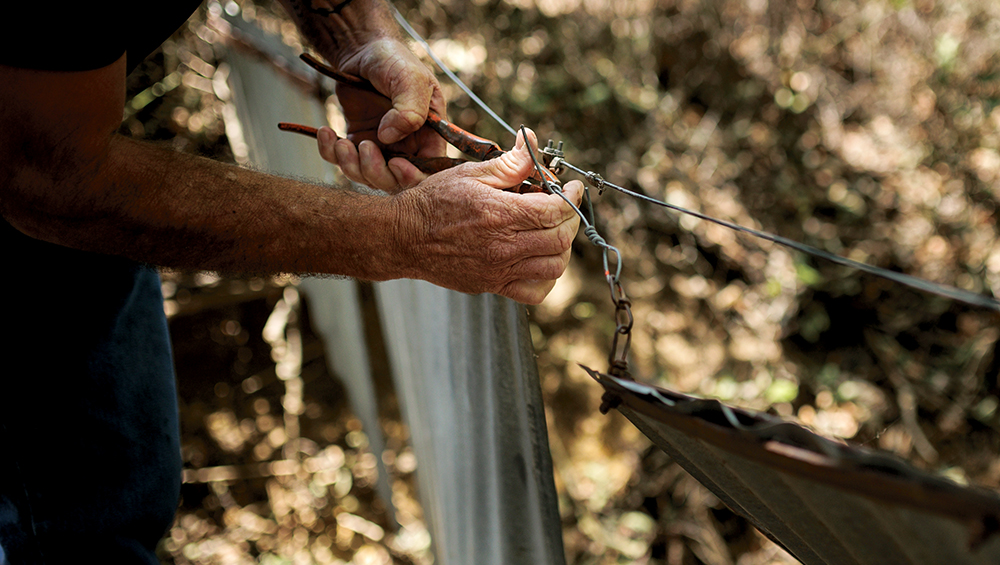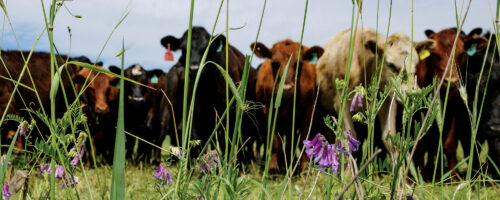Fencing Water Gaps and Low Areas
Devlon Ford, regenerative ranching advisor at Noble Research Institute, shares his advice and methods for fencing water gaps and low areas. Planning and maintaining water-gap fencing is vital for effective livestock management and protecting your property.
What types of water gaps have you encountered on your ranch?
Water gaps can vary depending on the terrain and water flow. They can occur in various low areas, not just creeks, and they need different approaches depending on the water flow and animal species grazing the area. Water gaps can be areas of erosion, seasonal flows or low spots that collect water. Depending on your property, you may need to construct a fixed water gap or a swing gap.
What fencing methods do you use for water gaps?
When it comes to fencing methods, you can use a range of materials like barn tin, dog chains, or polywire weighted with rocks. These materials are flexible and can move with the water flow, preventing damage to the fence. For more stable and continuous electric current, high-tensile wire is excellent. It spans across low areas and prevents cattle from crossing, even when water levels are low. Polywire is another practical and inexpensive option, though it might need replacement after heavy flooding.
I have a stream that runs into and across my ranch. Do I need to worry about a water gap?
Yes. Water gaps are essential for ensuring your livestock stay within your property lines while allowing water and debris to flow through without too much damage to your permanent fence. The ideal water gap functions as a floodgate, maintaining animal containment without obstructing the natural flow of water.
What should I consider when planning a water gap?
There are several factors to consider:
- Depth and width of the water: Understand the dimensions of your stream, creek or other water bodies.
- Water source and flow: Consider both the lowest and highest water levels throughout the year. This depends on whether your waterway spans a few feet or several feet. Note that in some states, it is illegal to fence navigable waters, so be sure to check local regulations before installing any fencing.
- Debris control: Consider how sticks, branches and other debris might accumulate in your gap, potentially causing harm.
- Soil stability: Determine if your soil is sturdy or erodible, as this will affect your fence’s durability. The banks of creeks, streams and other waterways hopefully have plants growing close to the edge. Growing plants will help hold the soil in place and are less susceptible to erosion than bare soil. These covered areas are a good place to install T-posts for strength and tension, while fiberglass posts are inexpensive and better for use in bare soil along the banks and the bottom of the channel.

How do different species impact my water-gap solutions?
Different animals need different water-gap designs. For cattle, I have used brush as a barrier when in a hurry, since they tend not to push through dense vegetation. However, sheep and goats can navigate these barriers, so you will need more secure options like high-tensile wire or polywire fencing. These materials adjust to varying water levels and can contain smaller, more agile animals. Electric fencing is also useful for sheep and goats to prevent escapes through small gaps.
Which materials are most suitable for constructing a water-gap fence?
For water-gap fencing, opt for galvanized pipes or wood that has been treated for high-moisture environments. These materials are ideal due to their durability in wet conditions. Ensure that the support posts are securely driven into a stable part of the bank.
How should I determine the appropriate type of fencing for water gaps?
Choosing the right fencing for water gaps does not follow a universal rule, as each site’s characteristics vary. Consider the following essential elements for effective water-gap fencing:
- Post placement on both banks: Install posts about 2-3 feet from the edge of the water to avoid areas susceptible to erosion.
- Wire or cable across the top: Attach a horizontal wire at the bottom of the posts, which corresponds to the top of the bank.
- Filling material for the gap: Utilize materials such as strands of electric wire to span the U-shaped gap down to the water’s surface.
The water level in my creek varies. How should I account for that in our water-gap fence?
The key is to ensure your gate matches the land’s contour. For high water, the gate should swing to float and allow debris to pass. In low water, it should prevent livestock from crossing underneath. In low areas without consistent water, fixed water gaps using strands of barbed wire or brush can help keep your gap effective in varying water levels.

Is it possible to extend an electric fence across a water gap in my cattle pasture?
Yes, you can. I recommend using a current limiter on your water gap section. This device maintains a charge to the rest of the fence even if your water gap grounds out. Electric fences act as psychological barriers for cattle, so ensuring consistent power is crucial. A current limiter helps prevent the fence from shorting out when water levels rise.
What are some common mistakes to avoid with electric fencing for water gaps?
Common mistakes include not securing hanging wires or chains properly, placing wires too low so they short out in slight rain, and incorrect spacing of wires. Ensure the wires are at the proper height and securely fastened to avoid these issues.
How often should I check and maintain my water-gap fences?
Regular maintenance is key, especially after rainfall. Knowing your area’s climate and how it affects water flow will help you anticipate when checks are needed. After significant rain events, inspect your water gaps to ensure they remain functional and intact.



Comment